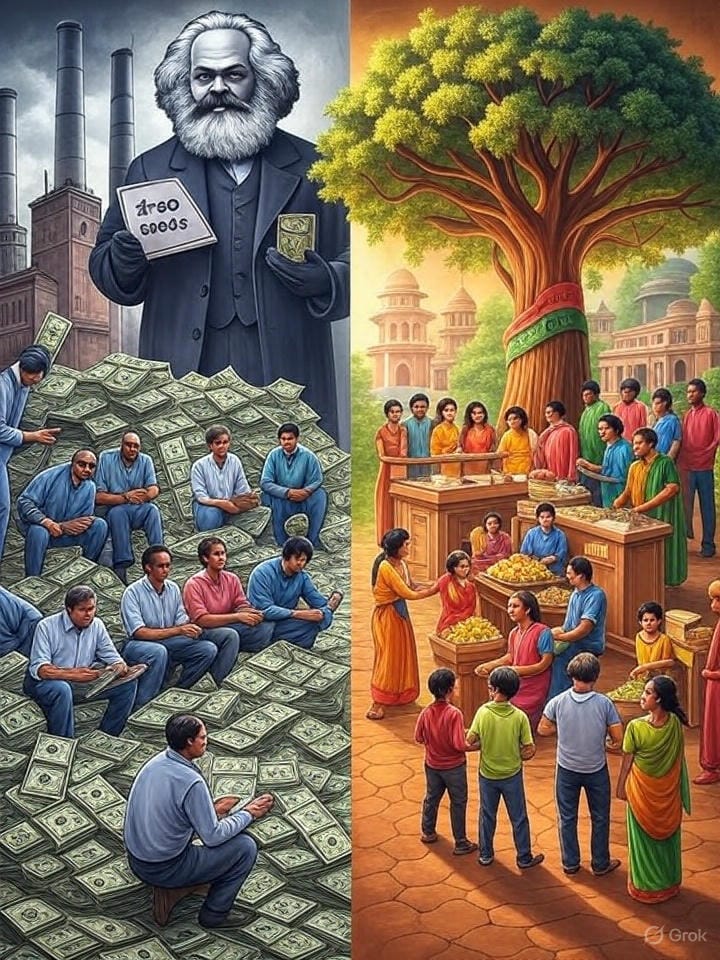The modern economic landscape, driven by extreme capitalism, has led to a cycle of exploitation so severe that it birthed its antithesis—extreme communism—as a response. This pendulum swing, from the unchecked profit-driven model of Adam Smith to the free handouts demanded by Karl Marx, reveals a deep flaw in the Western economic framework. In this article, I’ll explore how this exploitative system dismantled entrepreneurial communities, created unemployment, and fueled societal issues like depression, while proposing a preventive solution through the Sanatan Economics model—a return to family- and community-driven entrepreneurship rooted in traditional values.
The Roots of Exploitation: From Barter to Division of Labor
Before the 18th-century Industrial Revolution, the world operated on a barter system where enterprising families and communities thrived. Each unit produced an end product, controlling the entire value chain, and exchanged it with others. In this system, unemployment was unheard of—every family member contributed to creating a product, ensuring economic stability and self-sufficiency. There was no concept of depression, recession, or economic despair because wealth was distributed within communities, not concentrated in the hands of a few.
Enter Adam Smith and his concept of division of labor. While pitched as a way to increase efficiency and profit, this model destroyed the entrepreneurial spirit of families and communities. By breaking down production into isolated processes, where workers were unrelated and disconnected, the system stripped people of their legacy skills and turned them into mere laborers. The end product was no longer theirs to create or own; instead, wealth accumulated in the hands of a few capitalists. This extreme capitalism created a new reality: unemployment, poverty, and a classroom-to-job model that facilitated human trafficking by funneling people into exploitative labor systems.
The Birth of Extreme Communism as a Response
The exploitation reached such heights that Karl Marx emerged, advocating for free handouts from the state to counter the suffering of the masses. He argued that the state should provide “free seeds” to those unable to eat, a direct response to the extreme capital accumulation that left workers destitute. While Marx’s solution—extreme communism—may be flawed, as it fosters dependency on government handouts, it was a reaction to a real problem: the gross exploitation of society under unchecked capitalism.
Today, we see this cycle repeating itself. The West’s mountain of debt, fueled by extreme capitalism in banking, is paving the way for a digital communist currency—central bank digital currencies like the digital dollar. This is a natural consequence of exploitation: when you concentrate wealth in the hands of a few, the masses demand redistribution, often in unsustainable ways. But cursing communism misses the point—the source of the problem is extreme capitalism itself.
The Sanatan Economics Model: A Preventive Approach
Rather than relying on corrective measures like Marx’s handouts, which are neither sustainable nor hedge-proof, I propose a preventive approach through the Sanatan Economics model. This model reimagines the economic and educational framework to prioritize entrepreneurship and community empowerment, ensuring that the need for socialist “freebies” never arises.
- Education for Entrepreneurship: The first step is to overhaul the education system, which currently follows a Western template designed to produce workers, not thinkers or entrepreneurs. The textbook-based, memory-driven format—where a three-hour exam decides a student’s future—must be replaced with a Gurukul-style system that equips students with life skills and entrepreneurial knowledge. Entrepreneurship should be the first priority; those unable to pursue it can opt for jobs. This ensures that individuals are creators of value, not just cogs in a corporate machine.
- Religious Cap on Profits: By instilling Sanatani values, we can place a moral cap on profits, preventing the kind of exploitation that leads to extreme wealth disparity. When families and communities are empowered to create and exchange end products, they naturally engage in social welfare, reducing the need for government intervention.
- Reviving Family and Community Units: The Sanatan Economics model emphasizes the strength of family and community units. Historically, families who spent time with grandparents, exchanging knowledge and values, never knew depression—a concept now rampant in the West, fueling a massive pharma industry peddling “mental health” solutions. By contrast, the Western model encourages separation—linking GDP growth to buying new homes and living apart from family, then hypocritically promoting “family time” as a solution to the resulting loneliness.
The Western Template: A Cycle of Exploitation
The Western economic and educational model is a vicious cycle designed to benefit corporates and perpetuate exploitation. Schools and universities, often tied to Christian conversion agendas, prioritize profits over genuine education. Their research centers draw conclusions that serve corporate interests, not societal good. Meanwhile, urban centers, influenced by Western ideals, push a false narrative of empowerment—convincing women that a “career” (limited to specific jobs, not entrepreneurship) is the only path to success, further eroding family structures.
The obsession with GDP growth, tied to individualistic milestones like buying a house through loans, has dismantled the family unit. In the West, this has led to a culture where people live isolated lives, often with pets as their only companions, while battling mental health crises. The irony is stark: they break families apart, then market “family time” as a cure, all while profiting from the resulting societal breakdown.
